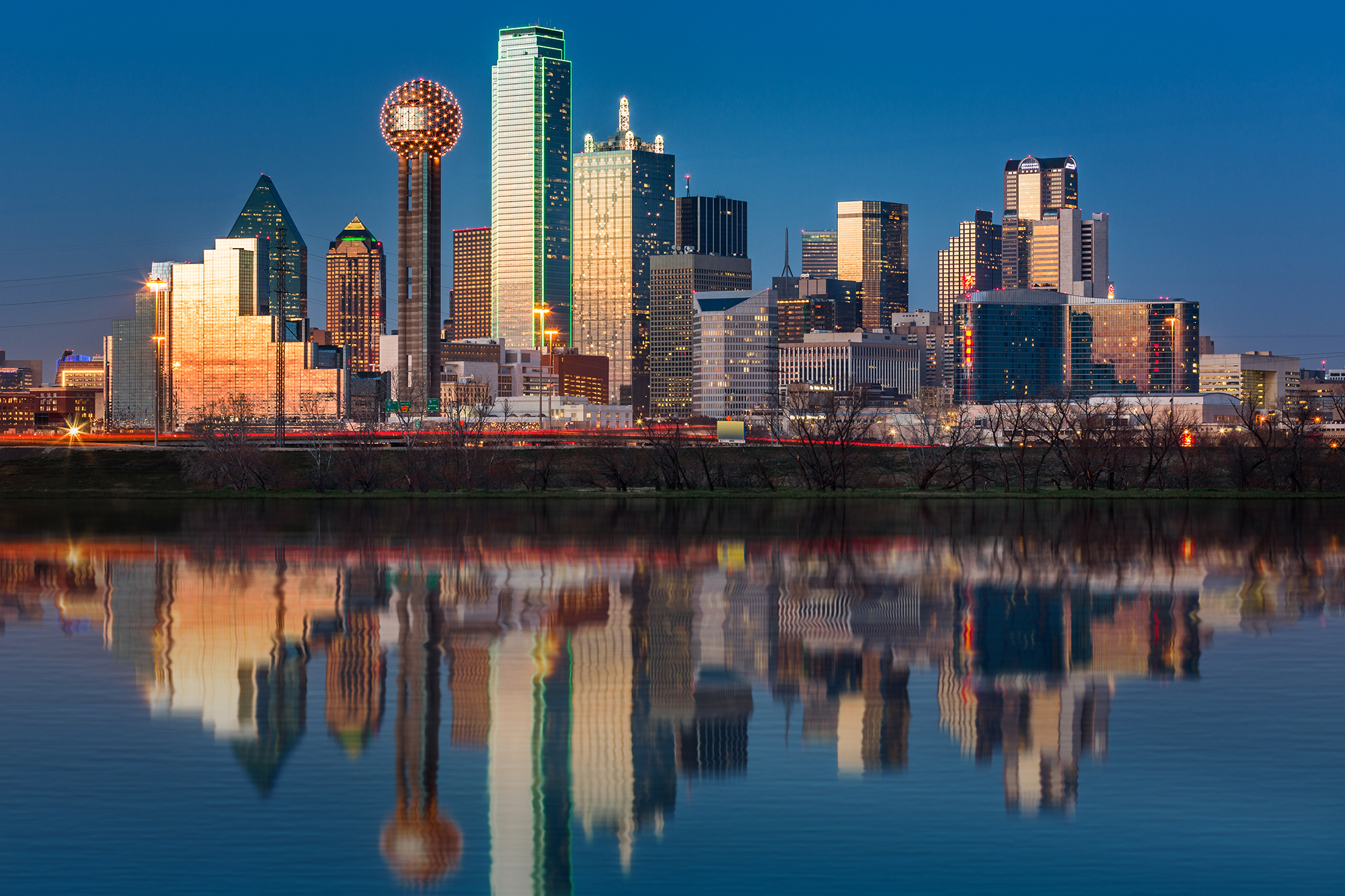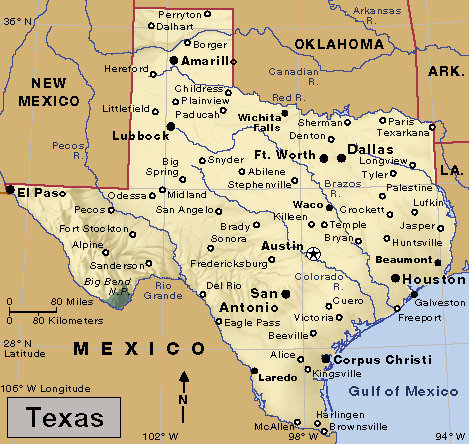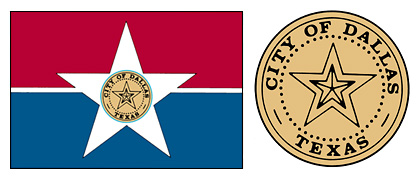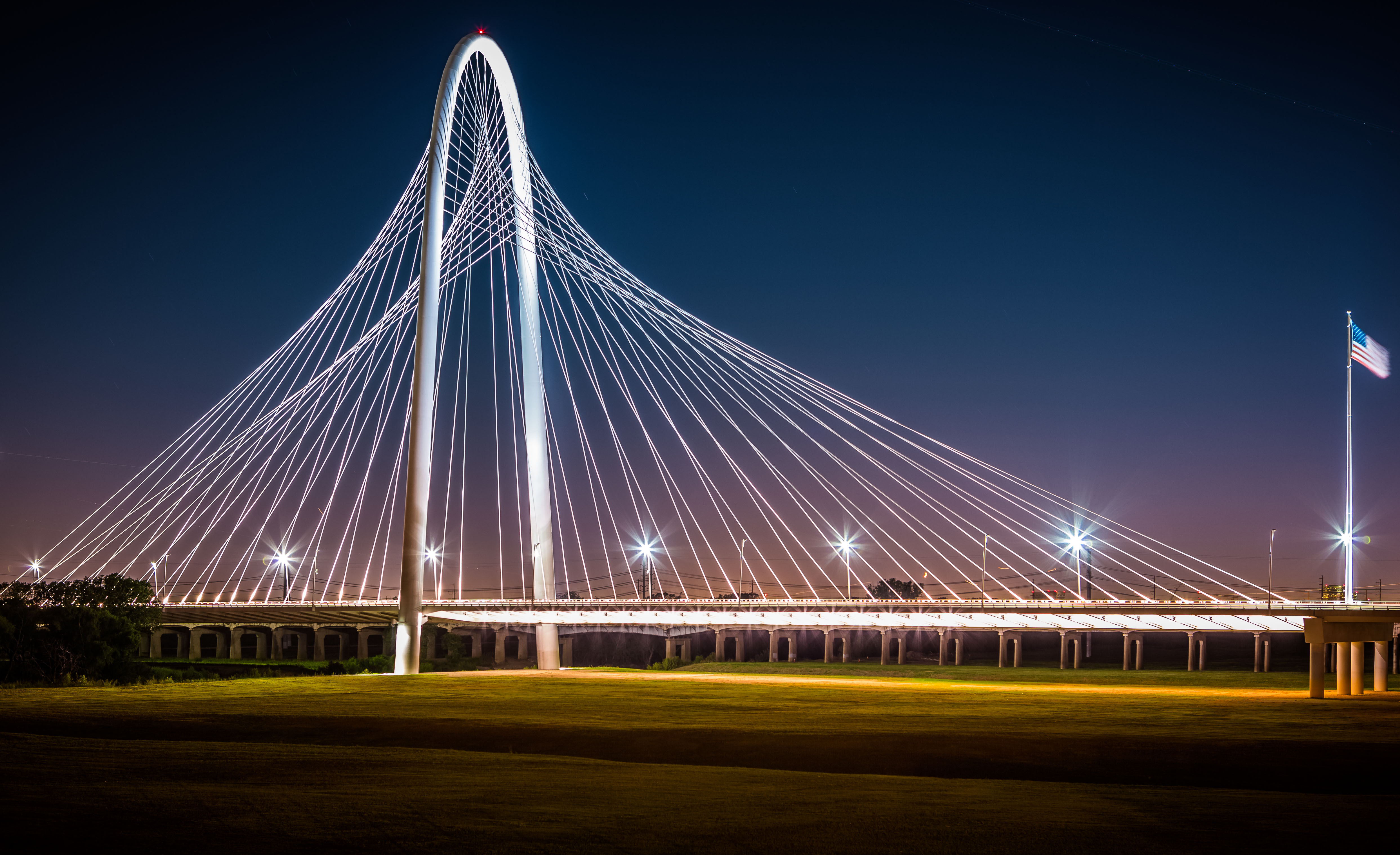Dallas is the third largest city in Texas and one of the largest in the United States. It is in the heart of one of the nation’s fastest growing metropolitan areas. Houston and San Antonio are the only Texas cities with more people. Nicknamed “Big D,” Dallas ranks as one of the nation’s major financial, insurance, manufacturing, and transportation centers. The city serves as the seat of Dallas County. 
Dallas stands on the rolling prairies of north-central Texas, about 30 miles (50 kilometers) east of Fort Worth. John Neely Bryan, a lawyer and trader, founded Dallas in 1841 on the banks of the Trinity River. The city’s rapid growth began when railroad companies constructed tracks through the city in the 1870’s. Today, the city’s financial success still depends on its transportation links. The Dallas/Fort Worth International Airport, which serves the two cities, is one of the busiest airports in the world. Convenient air service has helped the Dallas area become the national headquarters for many important United States companies.
The city
Layout of Dallas.
The Trinity River divides the city of Dallas. North and east of the river is the downtown business district. Oak Cliff, a residential area, lies south and west of the Trinity.


Outside the downtown area are sections of the city that are known as East Dallas, West Dallas, North Dallas, and South Dallas. Most of the city is in Dallas County, but small sections of Dallas extend into Denton and Collin counties. Three independent communities, each with its own government—Cockrell Hill, Highland Park, and University Park—lie within the Dallas city limits.

Landmarks.
The tallest building in downtown Dallas is the 72-story Bank of America Plaza, which opened in 1985. The West End Historic District, at the west edge of downtown, includes several historic sites. One is the Old Dallas County Courthouse, known as “Old Red,” which was built of red sandstone in 1892. The site was restored and opened as the Old Red Museum of Dallas County History & Culture in 2007. Others include Dealey Plaza and the Texas School Book Depository (now the Dallas County Administration Building). In 1963, President John F. Kennedy was killed in Dealey Plaza by a bullet fired from the sixth floor of the building. The depository’s sixth floor is now a museum depicting the events of Kennedy’s life and death. Near Dealey Plaza is a memorial honoring the late president.
In addition to the historic sites, the West End Historic District features shops and restaurants in restored warehouses. These warehouses were once owned by early Dallas merchants. South of Dealey Plaza is the 50-story Reunion Tower. The tower’s observation deck offers spectacular 360-degree views of the city and suburbs.
Shoppers flock to the original Neiman Marcus store in downtown Dallas. The Dallas City Hall, designed by American architect I. M. Pei, stands at the south end of downtown, at the center of the government district. A large sculpture, The Dallas Piece by English sculptor Henry Moore, decorates the City Hall Plaza. Next to the City Hall are the Kay Bailey Hutchison Convention Center Dallas and the J. Erik Jonsson Central Library, the main library of the Dallas Public Library system. The Convention Center has exhibition space and meeting rooms for trade shows and conferences. A bronze sculpture display of a cattle drive near the entrance to the center is a popular attraction.
The beautiful Majestic Theatre offers plays, musicals, concerts, and other entertainment and artistic events. Dallas Heritage Village, in the Old City Park south of downtown, is a living history museum that demonstrates how people lived and worked in northern Texas from 1840 to 1910. On the north side of downtown is the Dallas Arts District, site of the Dallas Museum of Art, the Nasher Sculpture Center, the Crow Museum of Asian Art, the Morton H. Meyerson Symphony Center, and the AT&T Performing Arts Center. The Dallas Market Center, a major wholesale buying center, lies along Stemmons Freeway northwest of downtown. The center also offers major exhibition space for trade shows. The Dallas Zoo in Oak Cliff has over 2,000 animals for visitors to see.
American Airlines Center, a sports arena, is just north of the downtown area. The Dallas Farmers Market on the southeast side of downtown offers fresh produce, flowers, and other goods from throughout Texas.
The Dallas metropolitan area
includes Collin, Dallas, Denton, Ellis, Hunt, Johnson, Kaufman, Parker, Rockwall, Tarrant, and Wise counties. The United States Census Bureau calls it the Dallas-Fort Worth-Arlington metropolitan area. Among the largest cities in the Dallas area are Arlington, Frisco, Garland, Grand Prairie, Irving, McKinney, Mesquite, and Plano. These suburban cities have many landmarks. The Heritage Farmstead Museum in Plano is a re-creation of farm life from 1890 to the 1930’s. Williams Square in Irving features a popular bronze sculpture of nine mustangs galloping across a stream.
People
Ethnic groups.
About 60 percent of Dallasites are white, and about 25 percent are African Americans. About 40 percent of the city’s people are Hispanic, who may be white, Black, or of mixed ancestry. The city’s population also includes many people of Arab, Native American, and Southeast Asian ancestry. Although Dallas no longer is segregated, the greatest number of African Americans live in South Dallas. There are large Hispanic neighborhoods in Oak Cliff and just north of downtown. Many people have moved to Dallas from other countries. About 70 percent of these immigrants come from Mexico. Many refugees from Southeast Asia have settled in older residential neighborhoods east of downtown. Most people who live in Dallas suburbs are white.
Housing.
Housing in Dallas is relatively new compared to other large cities. More than half of the housing units in Dallas have been built since 1970.
There are many different types of housing in the city and suburbs. Many of the biggest homes are in North Dallas neighborhoods, such as Preston Hollow, in the “island cities” of Highland Park and University Park, and in such higher-income suburbs as Irving, Plano, and Southlake. The Swiss Avenue Historic District in East Dallas features many mansions built by the city’s business leaders in the early 1900’s. Homes along Swiss Avenue began to be restored in the early 1970’s.
Some of the lowest-income housing is in West Dallas, an area the city did not annex until the early 1950’s. Before annexation, there were no construction guidelines in West Dallas to ensure that new structures were sturdily built and met other requirements. Today, the area has many run-down homes.
Social problems.
Like other large cities, Dallas has experienced crime, unemployment, and urban decay. However, the city has tried to reduce these problems by promoting job creation, downtown and inner-city construction, and other activities.
Dallas has also experienced some racial problems. For example, minority groups have lacked political and job opportunities in the city. But community organizations work to improve the prospects of minorities.
Another problem facing Dallas is air pollution, created primarily by vehicle traffic. The city government encourages motorists to car pool or use buses to reduce air pollution.
Education.
The Dallas Independent School District is one of the largest U.S. public school systems, with numerous elementary and high schools. The Dallas suburbs have many excellent public schools. Religious and other private schools provide education for many students in the metropolitan area. Greenhill School, Hockaday School, the Jesuit College Preparatory School of Dallas, and St. Mark’s School of Texas are among the area’s best-known private schools.
Southern Methodist University, in University Park, is the oldest and best-known university in the Dallas area. Founded in 1911, it offers strong programs in liberal arts and business administration. The University of Texas Southwestern Medical Center at Dallas has become a major facility for scientific research. Criswell College, Dallas Baptist University, the Dallas Theological Seminary, and the University of North Texas at Dallas are also in the city. Other schools of higher education in the Dallas area include the University of Texas at Dallas, in Richardson, and the University of Dallas, a Roman Catholic-affiliated school in Irving. In addition, the Dallas County Community College District consists of seven two-year community colleges in the Dallas area.
Cultural life
The performing arts.
Dallas is an important cultural center of the Southwest. The Dallas Arts District, in downtown Dallas, is the home of numerous cultural institutions. The AT&T Performing Arts Center, in the Arts District, is home to the Winspear Opera House and the Dee and Charles Wyly Theatre, among other performance spaces. The Dallas Opera performs at the Winspear Opera House. The Wyly Theatre hosts performances by the Dallas Theater Center, the Dallas Black Dance Theatre, and the Anita N. Martinez Ballet Folklorico. The Dallas Symphony Orchestra plays at the Morton H. Meyerson Symphony Center, also in the Dallas Arts District. The Texas Ballet Theater performs at the Winspear Opera House and at Bass Performance Hall in Fort Worth. Summer musicals at Fair Park and year-round performances by Shakespeare Dallas attract thousands of people each year.
The Kalita Humphreys Theater in the Turtle Creek area of North Dallas also hosts performing arts events. The American architect Frank Lloyd Wright designed the theater. A number of touring productions appear at the Majestic Theatre. Dallas Children’s Theater presents works for youth and families.
Museums and libraries.
The Dallas Arts District is the site of the Dallas Museum of Art, noted for its collections of art from Africa, the Americas, and Europe. The Nasher Sculpture Center is also in the district. The Perot Museum of Nature and Science stands to the west of the Arts District. The museum has exhibition spaces dedicated to such subjects as earth and space science, life science, dinosaurs, and engineering and inventions. It also features a children’s museum.
Fair Park, 2 miles (3.2 kilometers) east of downtown, contains buildings in the streamlined Art Deco style of architecture. Many of the buildings were constructed for the 1936 Texas Centennial Exposition, which celebrated 100 years of Texas independence.
Fair Park features several cultural institutions. The Texas Hall of State is run by the Dallas Historical Society. It displays historical documents as well as photos, costumes, and other items from everyday life in early Texas. The Perot Museum of Nature and Science also has a campus in the park. Each year in September and October, millions of people attend the State Fair of Texas in the park’s fairgrounds.
The Dallas Public Library System includes the J. Erik Jonsson Central Library downtown and many branch libraries throughout the city. On display at the Jonsson Central Library are a copy of the Declaration of Independence printed on July 4, 1776, and a First Folio—that is, a first edition of the collected plays of the English playwright William Shakespeare. The Dallas suburbs also have excellent libraries.
Recreation.
Dallas has hundreds of public parks. More than two-thirds of the city’s parkland is in the Trinity River Greenbelt, which is preserved as open space with few roads or buildings. White Rock Lake in East Dallas is a popular park for sailing, fishing, jogging, and biking. The Dallas Arboretum and Botanical Garden at White Rock Lake displays thousands of flowers and trees in an attractive lakeside setting. Six Flags Over Texas, in Arlington, is a theme park that offers amusement rides and shows. The International Bowling Campus in Arlington includes the International Bowling Museum and Hall of Fame and is the home of a number of major bowling organizations.
The Dallas area has teams in all four major professional sports. The Dallas Cowboys play in the National Football League. The Texas Rangers of the American League play major league baseball. The Dallas Mavericks compete in the National Basketball Association. The Dallas Stars play in the National Hockey League. Fair Park’s Cotton Bowl stadium hosts the Cotton Bowl football game each season, which features two outstanding college teams.
Economy
The Dallas area’s economy consists of a wide variety of industries. During the 1980’s, the area shifted from a manufacturing to a service-based economy.
Service industries.
Dallas depends heavily on convention business and tourism. Millions of people attend conventions in Dallas each year, adding billions of dollars to the economy. The city’s many banks make Dallas an important financial center for the southwestern United States. Dallas is the home of a great number of insurance companies. Dallas is also an important cotton market. Many computer software and Internet-related businesses are in the Dallas area.
Manufacturing.
The Dallas area is a major center for the manufacture of electronics and telecommunications equipment, food products, machinery, and printed material. Hundreds of industrial facilities provide jobs for the city’s labor force. The Dallas area also serves as the headquarters of many oil firms. Among the largest oil and gas companies in the area are the Exxon Mobil Corporation in Irving and the Dallas-based companies Atmos Energy Corporation, HollyFrontier Corporation, and EnLink Midstream.
Transportation and communication.
Dallas/Fort Worth International Airport and Dallas Love Field have helped make Dallas a vital transportation hub of the Southwest. Railroad companies provide freight and passenger service to the city. Dallas Area Rapid Transit (DART) and the Trinity Railway Express offer commuter rail service. AT&T, one of the world’s largest telecommunications companies, is headquartered in Dallas. The city has one daily newspaper, The Dallas Morning News.
Government
Dallas has a council-manager form of government. The City Council consists of a mayor and 14 council members. Dallas voters elect the mayor to a four-year term and the council members to two-year terms.
The council sets general policies for governing. It hires the city manager, who is the administrative head of the government. The manager carries out the policies of the council, prepares the annual city budget, and appoints department heads. The city’s chief sources of revenue include property taxes, sales taxes, and charges for services. Revenue bonds and federal grants also provide funds. The Dallas suburbs have their own independent local governments.
History
Early settlement.
In 1841, John Neely Bryan, a lawyer from Tennessee, dug a rough shelter in a hillside along the Trinity River, at the site of what is now Dallas. Bryan laid claim to 640 acres (260 hectares) of land and later built a log cabin home on the property. Dallas was made the temporary seat of Dallas County in 1846, while the town was still an obscure frontier village. It became the permanent seat in 1850. Bryan named the town Dallas, possibly after George Mifflin Dallas, vice president of the United States from 1845 to 1849.
Bryan sold and gave away lots to new settlers, and he laid out the streets of the town. Dallas began to grow. In 1855, a group of European scientists, writers, artists, and musicians settled near Dallas. The Europeans, most of whom came from France, Belgium, and Switzerland, formed a cooperative community known as La Reunion. The members of the community farmed a tract of land that they owned in common. But La Reunion failed, and many of its residents moved to Dallas, where they established businesses and helped promote the arts.
Dallas was incorporated as a town in 1856. The town became a stop for stagecoaches. During the American Civil War (1861-1865), Dallas served as a camp and an administrative center for the Confederate Army.
Commercial growth.
Dallas was incorporated as a city in 1871. The city’s financial growth began in the 1870’s, when two railroad lines—the Houston and Texas Central and the Texas and Pacific—reached Dallas and formed a junction. Farm tool manufacturers then began opening branches in Dallas. Cotton production boomed after rail shipment of the crop became possible. Dallas got its first telegraph line in 1872. By 1890, Dallas was the largest city in Texas, with 38,067 people.
By 1930, the Dallas population had grown to 260,475, but Houston had replaced it as the state’s largest city. Discovery of the great East Texas oil field 100 miles (160 kilometers) east of Dallas in 1930 helped boost the city’s economy and growth.
World War II (1939-1945) brought aircraft plants and other defense industries to the city. After the war, Dallas became a leading U.S. center for the manufacture of electrical and electronics equipment and aircraft and missile parts. Many large companies, including Chance Vought Aircraft (now Vought Aircraft Industries, Inc.), moved to Dallas. Companies founded in Dallas, such as the electronics manufacturer Texas Instruments Incorporated and the computer services company Electronic Data Systems, also expanded rapidly. Industrial growth helped the city’s population increase from 294,734 in 1940 to 844,401 in 1970. During this time, many Dallasites moved from the city to the suburbs.
On Nov. 22, 1963, Dallas was the site of President John F. Kennedy’s assassination. Vice President Lyndon B. Johnson was sworn in as president later that day aboard the presidential plane at Dallas Love Field airport.
During the early 1960’s, the population and economy of Dallas continued to expand. Mayor J. Erik Jonsson and city leaders turned to the “Goals for Dallas” program to plan for the city’s future. In 1967, Dallas voters passed a $175-million bond issue to fulfill some of these goals. The plans helped promote the construction of the Dallas/Fort Worth International Airport, which opened in 1974. Dallas also built a new city hall and the Martin Luther King, Jr., Community Center. The center provides many social services, such as rent assistance and health care for poor people.
Large companies continued to move their headquarters to Dallas during the 1970’s. New construction continued until the mid-1980’s, when oil prices fell, the real estate market declined, and Dallas experienced serious economic problems. The city began a financial recovery in the early 1990’s. At that time, the city had over 1 million people.
In 1995, Ron Kirk was elected mayor of Dallas. He became the city’s first African American mayor.
Recent developments.
In 1998, Dallas voters approved a bond issue to revitalize the Trinity River corridor. Plans included the construction of parks, wetlands, and bridges. The Margaret Hunt Hill Bridge, a key element of the project, opened in 2012. The highway portion of the Margaret McDermott Bridge was completed in 2017. Walking and biking sections of the bridge were completed in 2021.

On July 7, 2016, a gunman shot 12 police officers, killing 5, at what had been a peaceful protest march in downtown Dallas. Two civilians also were wounded in the shooting, which occurred at a rally protesting recent shootings of African American men by police. Dallas police killed the suspect with an explosive detonated by a police robot.
